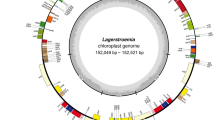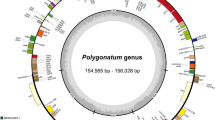Abstract
Pittosporum (Pittosporaceae) is famous as the ornamental and medical values, which is distributed tropical and subtropical regions of Eastern Hemisphere. The few phylogenetic studies have included samples from the Pacific Island, but the phylogenetic relationships of Asian species has not been studied. Here, the complete chloroplast (cp) genomes of ten Pittosporum species from East Asia were first sequenced and compared with those of the published species of this genus. Our results indicated that cp genomes of these species had a typical and conserved quadripartite structure. 131 genes were identical in order and orientation and no changes of inverted repeat (IR) occurred. However, the comparative analysis of cp genomes suggested that sequence divergence mainly appeared in non-coding or intergenic regions, in which several divergence hotspots were identified. By contrast, protein-coding genes showed the lowest variance under strong purifying selection. Phylogenetic analysis based on the cp genome sequences showed that the tested Pittosporum species were clustered into two major clades, in which the Asian species formed Clade I and the remaining species from Australia and New Zealand formed Clade II with high support values, which was consistent with the results of ITS data with low support values. These results suggested that cp genome is a robust phylogenetic indicator for deep nodes in the phylogeny of Pittosporum. Meanwhile, these results will provide the valuable information to better understand the phylogeny and biogeography of Pittosporum.




Similar content being viewed by others
Data availability
The data that support the findings of this study are openly available in the Science Data Bank at https://doi.org/https://doi.org/10.57760/sciencedb.08615 [https://doi.org/10.57760/sciencedb.08615].
References
Ahmed I, Biggs PJ, Matthews PJ et al (2012) Mutational dynamics of aroid chloroplast genomes. Genome Biol Evol 4:1316–1323
Amiryousefi A, Hyvönen J, Poczai P (2018) IRscope: an online program to visualize the junction sites of chloroplast genomes. Bioinformatics 34:3030–3031
Bowman CM, Bonnard G, Dyer TA (1983) Chloroplast DNA variation between species of Triticum and Aegilops. Location of the variation on the chloroplast genome and its relevance to the inheritance and classification of the cytoplasm. Theor Appl Genet 65:247–262
Cavalier-Smith T (2002) Chloroplast evolution: Secondary symbiogenesis and multiple losses. Curr Biol 12:R62–R64
Cayzer LW, Crisp MD, Telford IRH (2000) Revision of Pittosporum (Pittosporaceae) in Australia. Aust Syst Bot 13:845–902
Chandler GT, Plunkett GM, Pinney SM et al (2007) Molecular and morphological agreement in Pittosporaceae: phylogenetic analysis with nuclear ITS and plastid trnL–trnF sequence data. Aust Syst Bot 20:390–401
Cosner ME, Raubeson LA, Jansen RK (2004) Chloroplast DNA rearrangements in Campanulaceae: phylogenetic utility of highly rearranged genomes. BMC Evol Biol 4:27
Darling AC, Mau B, Blattner FR et al (2004) Mauve: multiple alignment of conserved genomic sequence with rearrangements. Genome Res 14:1394–1403
Deng JL, Huang R, Zhang QG et al (2022) Further sesquiterpenoids from Pittosporum qinlingense and their anti-inflammatory activity. Fitoterapia 162:105292
Drummond AJ, Suchard MA, Xie D et al (2012) Bayesian phylogenetics with BEAUti and the BEAST 1.7. Mol Biol Evol 29:1969–1973
Du YP, Bi Y, Yang FP et al (2017) Complete chloroplast genome sequences of Lilium: insights into evolutionary dynamics and phylogenetic analyses. Sci Rep 7:5751
El Dib RA, Eskander J, Mohamed MA et al (2015) Two new triterpenoid estersaponins and biological activities of Pittosporum tobira ‘Variegata’ (Thunb.) W. T Aiton Leaves Fitoterapia 106:272–279
Frazer KA, Lior P, Alexander P et al (2018) VISTA: computational tools for comparative genomics. Nucleic Acids Res 32:W273–W279
Gemmill CE, Allan GJ, Wagner WL et al (2002) Evolution of insular Pacific Pittosporum (Pittosporaceae): origin of the Hawaiian radiation. Mol Phylogenet Evol 22:31–42
Jansen RK, Palmer JD (1987) A chloroplast DNA inversion marks an ancient evolutionary split in the sunflower family (Asteraceae). Proc Natl Acad Sci USA 84:5818–5822
Katoh K, Kuma K, Toh H et al (2005) MAFFT version 5: improvement in accuracy of multiple sequence alignment. Nucleic Acids Res 33:511–518
Kearse M, Moir R, Wilson S-H et al (2012) Geneious Basic: An integrated and extendable desktop software platform for the organization and analysis of sequence data. Bioinformatics 228:1647–1649
Kurtz S, Choudhuri JV, Ohlebusch E et al (2001) REPuter: the manifold applications of repeat analysis on a genomic scale. Nucleic Acids Res 29:4633–4642
Librado P, Rozas J (2009) DnaSP v5: a software for comprehensive analysis of DNA polymorphism data. Bioinformatics 25:1451–1452
Ling LZ, Feng LT, Luo YL et al (2020) Characterization of the complete chloroplast genome and phylogenetic analysis of Pittosporum tobira (Pittosporaceae). Mitochondrial DNA Part B 5:1397–1398
Madikizela B, McGaw LJ (2017) Pittosporum viridiflorum Sims (Pittosporaceae): A review on a useful medicinal plant native to South Africa and tropical Africa. J Ethnopharmacol 205:217–230
Manase MJ, Mitaine-Offer AC, Miyamoto T et al (2013) New triterpenoid estersaponins from the root barks of Pittosporum verticillatum subsp. verticillatum and evaluation of cytotoxicities. Fitoterapia 91:231–235
McDonald MJ, Wang WC, Huang HD et al (2011) Clusters of nucleotide substitutions and insertion/deletion mutations are associated with repeat sequences. PLoS Biol 9:e1000622
Nicolas A (2009) Understanding evolutionary relationships in the angiosperm order apiales based on analyses of organellar DNA sequences and nuclear gene duplications. the degree of Doctor, Virginia Commonwealth University, Richmond, Virginia
Palmer JD (1991) Plastid Chromosomes: Structure and Evolution. In: Molecular T (ed) Bogorad L, and Vasil IK. Academic Press, Biology of Plastids, pp 5–53
Palmer JD, Zamir D (1982) Chloroplast DNA evolution and phylogenetic relationships in Lycopersicon. Proc Natl Acad Sci USA 79:5006–5010
Phan ADT, Chaliha M, Hong HT et al (2020) Nutritional value and antimicrobial activity of Pittosporum angustifolium (Gumby Gumby), an Australian indigenous plant. Foods 9:887–903
Prjibelski A, Antipov D, Meleshko D et al (2020) Using SPAdes De Novo Assembler. Curr Protoc Bioinformatics 70:e102
Qu XJ, Moore MJ, Li DZ et al (2019) PGA: a software package for rapid, accurate, and flexible batch annotation of plastomes. Plant Methods 15:1–12
Raubeson LA, and Robert K J (2005) Chloroplast genomes of plants. Plant Diversity and Evolution Genotypic and Phenotypic Variation in Higher Plants Edited by R J Henry Wallingford UK: CABI Publishing 42:45–68
Raubeson LA, Jansen RK (1992) Chloroplast DNA evidence on the ancient evolutionary split in vascular land plants. Science 255:1697–1699
Rjeibi I, Ncib S, Ben Saad A et al (2017) Evaluation of nutritional values, phenolic profile, aroma compounds and biological properties of Pittosporum tobira seeds. Lipids Health Dis 16:206
Ronquist F, Huelsenbeck JP (2003) MrBayes 3: Bayesian phylogenetic inference under mixed models. Bioinformatics 19:1572–1574
Röschenbleck J, Wicke S, Weinl S et al (2017) Genus-wide screening reveals four distinct types of structural plastid genome organization in Pelargonium (Geraniaceae). Genome Biol Evol 9:64–76
Sajjad A, Khan AL, Khan AR et al (2016) Complete chloroplast genome of Nicotiana otophora and its comparison with related species. Front Plant Sci 7:1–12
Stamatakis A (2006) RAxML-VI-HPC: maximum likelihood-based phylogenetic analyses with thousands of taxa and mixed models. Bioinformatics 22:2688–2690
Stephan G, Pascal L, and Ralph B (2019) OrganellarGenomeDRAW (OGDRAW) version 1.3.1: expanded toolkit for the graphical visualization of organellar genomes. Nucleic Acids Res 47:W59–W64
Sytsma KJ, Schaal BA (1985) Phylogenetics of the Lisianthius skinneri (gentianaceae) species complex in panama utilizing DNA restriction fragment analysis. Evolution 39:594–608
Thodi RC, Ibrahim JM, Surendran VA et al (2022) Rutaretin1’-(6″-sinapoylglucoside): promising inhibitor of COVID 19 mpro catalytic dyad from the leaves of Pittosporum dasycaulon miq (Pittosporaceae). J Biomol Struct Dyn 40:12557–12573
Yang JB, Li DZ, Li HT (2015) Highly effective sequencing whole chloroplast genomes of angiosperms by nine novel universal primer pairs. Mol Ecol Resour 14:1024–1031
Zhang S-D, Ling L-Z (2022) Molecular structure and phylogenetic analyses of the plastomes of eight Sorbus Sensu Stricto species. Biomolecules 12:1648
Acknowledgements
We thank Germplasm Bank of Wild Species, Kunming Institute of Botany, Chinese Academy of Sciences for providing the samples.
Funding
This research was funded by the National Natural Science Foundation of China, grant number 31860052, Science and Technology Program of Liupanshui, grant number 52020-2020-PT-20 and Program for Training Innovation and Entrepreneurship of University Graduates of Liupanshui Normal University, grant number 2021cxcy101.
Author information
Authors and Affiliations
Contributions
L.Z. L conceived and designed the study. S.D. Z, Q.H. Z and L.Z. L performed the experiments, analyzed the data and wrote the manuscript. L.Z. L revised the manuscript.
Corresponding author
Ethics declarations
Competing interests
The authors declare no competing interests.
Additional information
Publisher's Note
Springer Nature remains neutral with regard to jurisdictional claims in published maps and institutional affiliations.
Supplementary information
Below is the link to the electronic supplementary material.
Rights and permissions
Springer Nature or its licensor (e.g. a society or other partner) holds exclusive rights to this article under a publishing agreement with the author(s) or other rightsholder(s); author self-archiving of the accepted manuscript version of this article is solely governed by the terms of such publishing agreement and applicable law.
About this article
Cite this article
Zhang, SD., Ling, LZ. & Zhang, QH. Comparative and phylogenetic analysis of the complete chloroplast genomes of ten Pittosporum species from East Asia. Funct Integr Genomics 24, 64 (2024). https://doi.org/10.1007/s10142-024-01344-9
Received:
Revised:
Accepted:
Published:
DOI: https://doi.org/10.1007/s10142-024-01344-9




